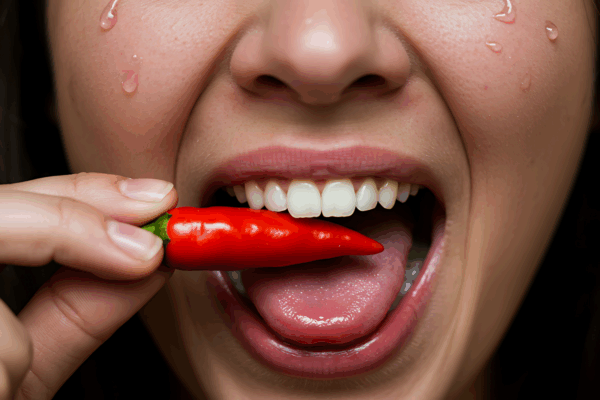The spicy food revolution is reshaping American dining, and the latest data reveals just how dramatically our taste for heat has evolved. From explosive growth in spicy food trends to unprecedented menu adoption, the numbers paint a picture of a nation falling in love with fiery flavors.
Spicy Food Dominates Restaurant Menus Nationwide
Today’s spicy food landscape tells a remarkable story: 95.3% of restaurant menus now feature spicy food options, marking a significant increase from 91.6% in 2015. This spicy food trend spans every region, proving that America’s appetite for heat knows no geographical boundaries.
And here’s a stunning stat to illustrate this: The word ‘spicy’ is now on more menus than any other word besides ‘fruit’ or ‘vegetable.’ It even surpasses chicken, America’s favorite protein.
Regional spicy food adoption shows impressive consistency:
- South: 94.6% (leading the spicy food charge)
- West: 93.8%
- Northeast: 93.9%
- Midwest: 93.2%
The future of spicy food looks even hotter. Projections indicate that by 2029, 96.3% of menus will feature spicy food items, with the South reaching 95.8% penetration—cementing spicy food trends as a permanent fixture in American dining.
Spicy Food Menu Items Multiply Across Categories
Beyond simple menu presence, spicy food trends are driving deeper menu integration. 9.4% of all menu items now incorporate spicy elements, representing 9% growth over four years. This translates to approximately 26,000 additional spicy food options compared to 2015 levels.
The most surprising spicy food trends emerge from unexpected categories. Traditional comfort foods are embracing heat in unprecedented ways:
Fastest-Growing Spicy Food Categories (4-Year Growth):
- Pizza: +53% spicy food options (+121% over 10 years)
- Coffee & Bakery: +40% spicy food integration
- Burger: +35% spicy food offerings
- American Cuisine: +32% spicy food adoption
- BBQ: +30% spicy food menu expansion
Spicy Food Trends Transform Traditional Menu Items
The most dramatic spicy food trends appear in classic American favorites. Appetizer samplers lead spicy food innovation with 78% growth—jumping from 5.8% to 11.1% featuring spicy elements. Handheld proteins like wings and chicken fingers show 66% spicy food growth, while even cocktails join the trend with spicy margaritas increasing 42%.
These spicy food trends reflect sophisticated flavor development, moving beyond simple “hot sauce added” approaches to integrated spicy food experiences that enhance rather than overpower core flavors.
Consumer Demand Fuels Spicy Food Trends
Consumer enthusiasm drives these spicy food trends. 65% of Americans either love or like spicy food, with 34% in the “love it” category actively seeking spicy food experiences. While 35% remain neutral or negative toward spicy food, the passionate advocates create significant market pull.
Purchase intent data reveals the true impact of spicy food trends: over half of consumers now express likelihood to buy items specifically labeled as “spicy”, compared to just 39% in 2015. This dramatic shift in spicy food purchasing behavior represents one of the most significant food trend evolutions in recent years.
Generational Differences Shape Spicy Food Trends
Age demographics heavily influence spicy food trends. Younger consumers drive spicy food innovation, showing higher affinity for heat and earlier adoption of emerging spicy food trends. They’re embracing next-generation spicy ingredients like:
- Piri Piri sauce – Portuguese-inspired heat
- Chili crisp – Textured Chinese condiment trend
- Nam Phrik – Thai spicy sauce varieties
However, younger demographics also demonstrate faster spicy food trend fatigue. While they initially champion trends like sweet-and-spicy combinations and Nashville Hot, they migrate to newer spicy food trends even as previous favorites gain mainstream acceptance.
Seasonal Spicy Food Trends and Innovation Cycles
Spicy food trends show distinct seasonal patterns. Summer months favor classic spicy food combinations like spicy garlic and spicy BBQ, while fall brings complex spicy food profiles featuring spicy ginger and spicy peanut sauce applications.
Recent spicy food innovation remains robust: 76 new spicy food items launched in four months (March-June 2025), though the percentage of total new items classified as spicy food has moderated to 4.7% as the category matures.
The Future of Spicy Food Trends
Current data suggests spicy food trends represent fundamental shifts rather than passing fads. Restaurant operators ignoring spicy food trends risk missing significant consumer demand as diners increasingly prioritize bold, spicy food experiences.
Key Spicy Food Trend Indicators:
- Sustained growth across all regions and demographics
- Integration into unexpected food categories
- Strong purchase intent and consumer enthusiasm
- Continuous innovation in spicy food ingredients and applications
Spicy Food Trends: The New Normal
These spicy food trends signal a permanent transformation in American dining preferences. As younger consumers drive spicy food adoption and mainstream diners embrace heat, restaurants must adapt their spicy food strategies to remain competitive.
The trajectory of spicy food trends points toward continued expansion. With demographic shifts favoring spicy food consumption and ongoing culinary innovation, the next phase of spicy food trends promises even greater integration into American dining culture.
Whether you’re a spicy food enthusiast or still exploring the trend, one truth emerges: spicy food has evolved from niche preference to mainstream expectation, fundamentally reshaping how America eats.
 EN | English UK
EN | English UK DE | Deutsch
DE | Deutsch FR | Français
FR | Français IT | Italiano
IT | Italiano SP | Español
SP | Español





